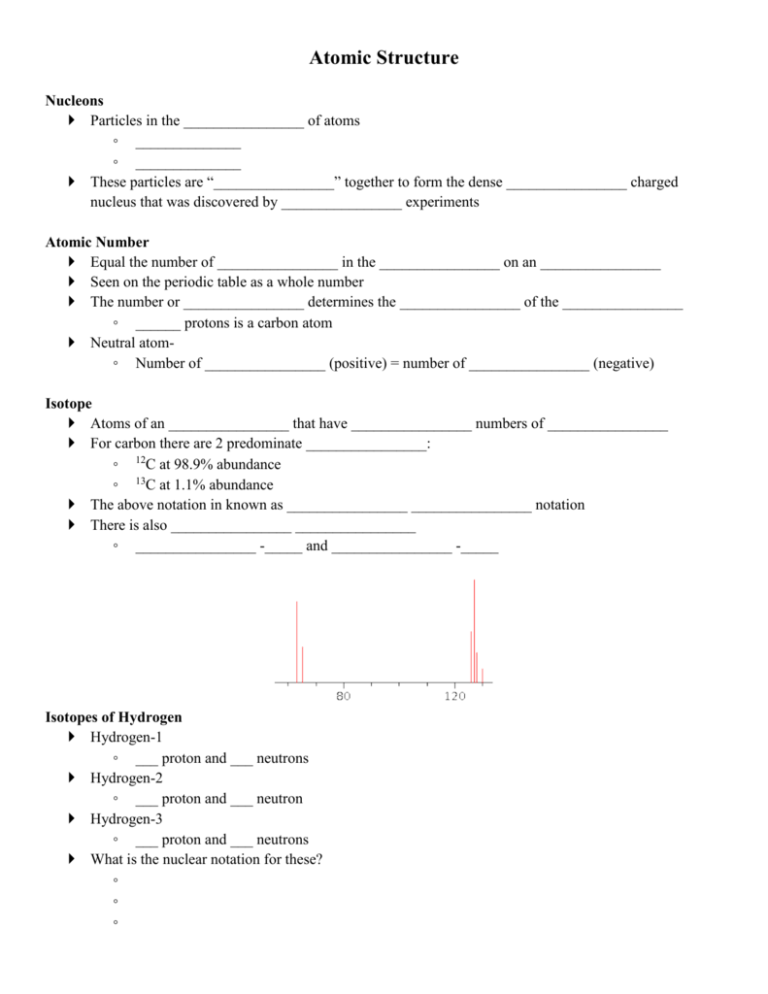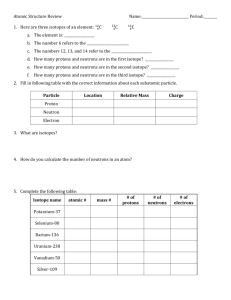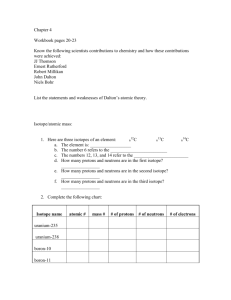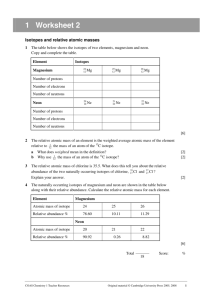Atomic Structure
advertisement

Atomic Structure Nucleons Particles in the ________________ of atoms ◦ ______________ ◦ ______________ These particles are “________________” together to form the dense ________________ charged nucleus that was discovered by ________________ experiments Atomic Number Equal the number of ________________ in the ________________ on an ________________ Seen on the periodic table as a whole number The number or ________________ determines the ________________ of the ________________ ◦ ______ protons is a carbon atom Neutral atom◦ Number of ________________ (positive) = number of ________________ (negative) Isotope Atoms of an ________________ that have ________________ numbers of ________________ For carbon there are 2 predominate ________________: ◦ 12C at 98.9% abundance ◦ 13C at 1.1% abundance The above notation in known as ________________ ________________ notation There is also ________________ ________________ ◦ ________________ -_____ and ________________ -_____ Isotopes of Hydrogen Hydrogen-1 ◦ ___ proton and ___ neutrons Hydrogen-2 ◦ ___ proton and ___ neutron Hydrogen-3 ◦ ___ proton and ___ neutrons What is the nuclear notation for these? ◦ ◦ ◦ Example Problem #1 Write the following elements in the opposite notation given. 1. Copper-63 7 2. Li 3. Silver-108 22 4. Ne Mass number Total number of ________________ and ________________ in an atom The mass number is always a ________________ number Looking at Carbon-12, how many protons and neutrons? ◦ ___ protons and ___ neutrons ________________ of ________________ = mass number - ________________ ________________ are ignored in mass number calculations because they weight 1/2000th of a proton Example Problem #2 How many protons and neutrons are in 63Cu? How many protons and neutrons are in 39K? Atomic Mass ________________ of the masses of all element’s ________________ How do we arrive at 12.011 g/mol if ________________ and ________________ each weigh 1 amu? ◦ The average of all of the ________________ of ________________ can be used to calculate the ________________ mass of an element Calculating Atomic Mass Using ________________ we can solve for the ________________ Mass of an element using the following equation: (mass of isotope A)(Percent abundance of A) + (mass of isotope B)(Percent Abundance of B) +…. = Molar Mass Solving Atomic Mass For carbon there are 2 predominate ________________: ◦ 12C at 98.9% abundance ◦ 13C at 1.1% abundance Molar Mass = 12*0.989 + 13*0.011 Molar Mass = 11.868 + 0.143 Molar Mass = 12.011 g/mol Example Problem #3 Isotopes of potassium are: ◦ 39K at 93.26% abundance ◦ 40K at 0.012% abundance ◦ 41K at 6.73% abundance Practice Problem #1 Isotopes of Silver are: ◦ 107Ag at 51.839% abundance ◦ 109Ag at 48.161% abundance Particle Charge Practice Problem #2 Number of protons? ◦ Number of electrons? ◦ Number of neutrons? ◦ Mass Location Practice Problem #3 Number of protons? ◦ Number of electrons? ◦ Number of neutrons? ◦




